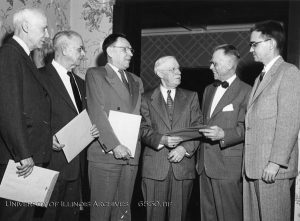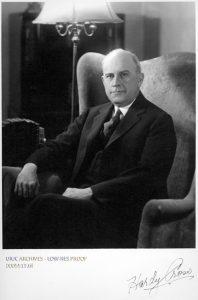In February, the University Archives acquired the papers of Thomas Clark Shedd, Professor of Civil Engineering at the University of Illinois from 1925 through 1958. Comprising correspondence, publications, photographs, a field notebook, and even a slide rule, Shedd’s papers document his research on railway and bridge design as well as his interest in teaching and the development of the structural engineering curriculum. This acquisition is important not only for shedding light on his career and research, but also for his influence on the Department of Civil Engineering (now Civil and Environmental Engineering), especially in terms of its instructional mission.[1] Most notably, his papers include a great deal of correspondence with his colleague and long-time friend, Hardy Cross, Professor of Civil Engineering at the U of I from 1921 to 1937. Shedd’s papers thus complement the University Archives’ substantial collection of administrative records and personal papers relating to civil engineering, including Hardy Cross’ papers.

Thomas Clark Shedd first became acquainted with Hardy Cross at Brown University, where he graduated with a B.S. in mechanical engineering in 1913. Cross, who served as Assistant Professor from 1911 through 1918, proved to be an instructive mentor to Shedd; reflecting upon his time teaching at Brown, Cross said, “Taught Professor Shedd there…My most important accomplishments are teaching men like him.”[2] Despite his civil engineer mentor, Shedd was a mechanical engineer by education; likewise, it appeared he had “deserted what amounted to a family tradition and forsaken the study of civil engineering.”[3] Having a father, grandfather, and uncles who worked as civil engineers, it seemed Shedd had indeed alighted on a slightly different career path. His work at the Phoenix Bridge Company after graduation, however, brought him back to his roots – an experience that, along with the influence of Hardy Cross, would prove instrumental to his career at the University of Illinois, where he would devote himself to the “economics of structural design.”[4]
In 1921, Cross began teaching in the Department of Civil Engineering at the University of Illinois. A year later, Shedd also joined the Civil Engineering faculty at the U of I, where he was appointed Associate in Engineering, and later full Professor in 1936. It was during his early days at the U of I that Shedd continued his education, acquiring both a professional degree and a Master of Science in Civil Engineering in 1925 and 1933, respectively. In addition to his academic duties, he served on the Illinois Structural Engineers Examining Committee (1922-1958) and the Illinois Professional Engineers’ Examining Committee (1944-1959), while also working as a bridge design consultant for a number of firms, such as Waddell & Hardesty and Anaconda Copper. Among his most notable projects as a consultant, Shedd contributed to the construction of the steel frame that supported the 4 million pound and 180 feet in diameter “city of tomorrow” Perisphere displayed at the New York World’s Fair in 1939.

Both Shedd and Cross had a considerable impact on the field of structural engineering. During his career, Shedd authored the foundational texts, Structural Design in Steel (1934) and Theory of Simple Structures with J. Vawter (1931). Simple Structures made the fundamentals of design and analysis understandable to a new generation of structural engineers, having influenced the professionalization of structural engineering in an era when many developments in the field emerged.[5] Likewise, Cross was recognized for his seminal publications. In 1932, he published “Analysis of Continuous Frames by Distributing Fixed-End Moments,” in the transactions of the American Society of Civil Engineers, which fundamentally influenced the analysis of indeterminate structures. Known as “Moment Distribution,” or the “Hardy Cross Method,” Cross’ idea provided a numerical solution of the slope-deflection equations that was used in the design of complex structures.[6]
The vast majority of Shedd’s correspondence with Cross occurred after the latter became head of Civil Engineering at Yale University in 1937. Their correspondence contains discussions on the nature of the engineering profession and education, their respective departments, teaching (such as Shedd’s course on bridge design), familial affairs, and new theories and developments in the field. In one letter, Cross recounted his difficulty recruiting new faculty to Yale. He outlined not only his expectations for such a candidate, but also more broadly his thoughts on the direction of the civil engineering curriculum:
I have come to the conclusion that we must very definitely pay more attention in civil engineering to what are often sloppily called the “broad aspects.”…The opportunity is here is for a man who can see the problems as distinguished from past practice in the development of railways, highways, aviation, and inland navigation and correlation of them. This can be done, of course, to some extent by inter-relating courses in economics to engineering. It has not, however, been done successfully that way anywhere that I have heard of and I am pretty certain that if it is to be done sanely, it should be done in engineering and not merely through engineering. I want to look at these matters from the engineering point of view which I think may be interpreted to mean that we draw some pictures and put down some figures and then quarrel with the pictures and figures. The engineer, I think, forces his mind to think in terms of physical property rather than metaphysical concepts.[7]
In his reply to Cross, Shedd wrote, “I was greatly interested in your remarks about the “broad aspects” of civil engineering, and I can see that you have gone cultural in a big way.”[8] Cross and Shedd continued to discuss new ways of reformulating the engineering curriculum to include more coursework on philosophy, economics, and history. Cross had previously presented a paper titled “Educational Inflation” in 1937, which discussed his ideas concerning the civil engineering curriculum: “We have two responsibilities…We must give them enough vocational education to get and hold a job till they are rooted in a competitive world. Our other duty – much the more important – is to train them in methods of thinking and investigation so that they can meet the demands of society.”[9]
It could be said that Shedd fulfilled Cross’ philosophies on teaching. At the same time, Shedd’s approach to teaching had a profound impact on Cross’ own ideas: “Without qualification I consider Mr. Shedd the greatest teacher of undergraduate structural design…I often drop in to listen to his explanations to Seniors of layout and detail because I come away a better teacher and a better engineer.”[10] No doubt, the correspondence of Shedd and Cross enables us to begin tracing the early development of the structural engineering curriculum and thus its influence on several generations of engineers.
[1] W. J. Hall and A. S. Elnashai, Leadership and Legacy: A History of Civil and Environmental Engineering at Illinois, (Urbana: University of Illinois Board of Trustees, 2011), 36.
[2] M. L. Enger, “Interesting Faculty Facts,” The Technograph, April 1936, 15, Record Series 26/4/1, University of Illinois Archives.
[3] “Meet the Faculty,” Daily Illini, March 22, 1939, Record Series 26/4/1, University of Illinois Archives.
[4] “Thomas Clark Shedd,” The Technograph, May 1938, Records Series 26/4/1, University of Illinois Archives.